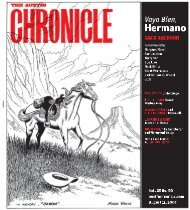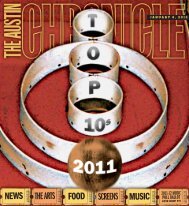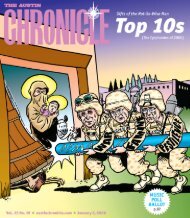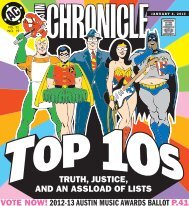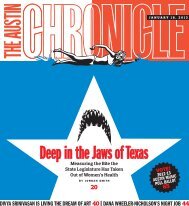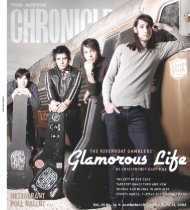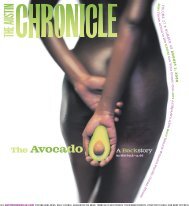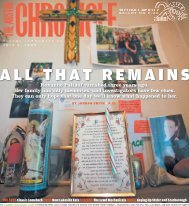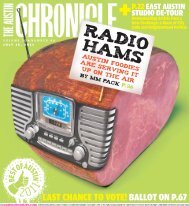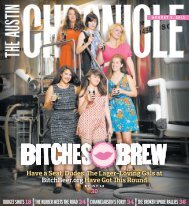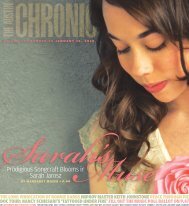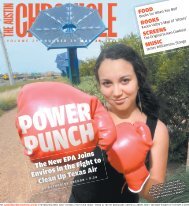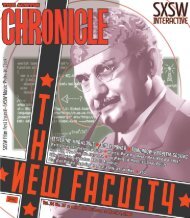R E S T A U R A N T P O L L B A L L O T P . 4 6 - The Austin Chronicle
R E S T A U R A N T P O L L B A L L O T P . 4 6 - The Austin Chronicle
R E S T A U R A N T P O L L B A L L O T P . 4 6 - The Austin Chronicle
- No tags were found...
Create successful ePaper yourself
Turn your PDF publications into a flip-book with our unique Google optimized e-Paper software.
NEWSBump in the Road for Bike Boulevard“First they took the word ‘Nueces’ out andbegan calling it the ‘Downtown Bike BoulevardProject,’ and now with this plan, they’veessentially removed the word ‘bike’ as well.”That was the reaction of Rob D’Amico, presidentof the League of Bicycling Voters,when the city of <strong>Austin</strong>’s Public WorksDepartment released its draft plan for a bicycleboulevard through the western side ofDowntown on Tuesday.<strong>The</strong> first half of his statement is true – inthe draft, much of the traffic calming andother devices intended to benefit bicyclistshave been moved from Nueces Street, asoriginally proposed late last year, and over toRio Grande Street.<strong>The</strong> second half is up for debate – citybicycle program coordinator Annick Beaudetdefended the plan vigorously,and the bicycling communityis not necessarily of onevoice on the matter. As forthe business owners whoopposed the project altogether,their representative didnot return phone calls as ofpress time. <strong>The</strong> plan will nowwork its way through thecity’s boards and commissionsprocess and is currentlyscheduled to go to CityCouncil on May 13.Quite different from the plan LOBV offered– which would have removed four-way stopson Nueces and implemented a number ofdevices including “partial diverters” to discouragethrough traffic – city staff is recommendingthe addition of “enhanced” bicyclelanes (possibly marked with different colors)along Nueces, from 13th to MLK and Third toSeventh, with “sharrows” (lanes marked forshared use by cyclists and autos) betweenSeventh and 13th. Also, staff wants thespeed limit reduced from 30 mph to 25 mph.Meanwhile, Rio Grande would see drop-off/pick-up insets for <strong>Austin</strong> Community Collegeand Pease Elementary, back-in angle parking,In place of variousdevices to discouragethrough traffic, citystaff is recommendingthe addition of“enhanced” bicyclelanes (possibly markedwith different colors).a new traffic signal at Fifth, plus speed cushionsand other traffic-calming devices. Andthere are other elements of the plan thatD’Amico does like, such as a new bridge connectingFourth and Rio Grande to the ShoalCreek Trail and Lance Armstrong Bikeway.<strong>The</strong> battle over the boulevard has beenintense in recent months, with business ownersalong Nueces insisting that reducing trafficwould harm them, as well as kill off futureredevelopment of the area. <strong>The</strong> LOBV pointedout that most of the businesses are appointment-orientedand that autos would not actuallybe banned from the street.“What once was a vision for defining a keycorridor to move <strong>Austin</strong>ites in and out ofDowntown by bicycles has turned into a planfor pushing bikes to the side to make surecars aren’t burdened,”D’Amico said. He saidLOBV will now work to getthe draft amended in theboards and commissions.“That couldn’t be furtherfrom the truth,” saidBeaudet in response. “Thisstaff recommendation isresponsive to stakeholderinput while still creating anamazing bicycle boulevard,an amazing bicycle facility,to preserve and enhance bicycle mobility. … Iam so proud of this recommendation.”<strong>The</strong> cycling community was never monolithicin its opinion; some had touted Rio Grandeas the better option all along. But D’Amicohad begun attacking the plan before it wasreleased (he participated in negotiations overits design) and was rebuked by Hill Abell,owner of Bicycle Sport Shop. “After havingread it, unlike somebody else that’s beencommenting on it for the last couple of days,I’m in full support of it,” Abell said. “If you …read [in the staff report] all the reasons thatNueces simply cannot support what would beconsidered a true bicycle boulevard, it makesperfect sense, because you can’t have a bicy-JANA BIRCHUM<strong>The</strong> city of <strong>Austin</strong> has switched gears on a plan to turn this ordinaryNueces Street into a full-fledged bicycle boulevard.cle boulevard with traffic levels truly over3,000” cars per day. Abell said that the<strong>Austin</strong> Cycling Association is reservingjudgment on the plan until they’ve read it.<strong>The</strong> city expects traffic count mightincrease when Nueces is extended to connectwith Cesar Chavez Street as part of theSeaholm project. Another major factor is thata water line replacement for Nueces isscheduled for 2011, “making any significantsurface infrastructure improvements toNueces not as attractive as Rio Grande,”according to the report.“One of the frustrations that I feel andsome within the cycling community feel withthe LOBV is that they’re simply looking atwhat’s the very best for bicyclists. I appreciatethat. That’s where we have to start. Butthen we have to be willing to take in inputfrom all the people in our community that willbe impacted,” Abell said.“We started with a concept, and we wentthrough this process, and we came out theother end with a better project,” Beaudet said.“I stand behind it. … We’ve done our job as abike program to provide good bicycle facilities inthis area, and we’ve also done our job as plannersto serve the public interest in listening toall the other stakeholder issues and concernsand other things going on in that area related todevelopment, related to economic growth, relatedto a lot of things. I hate to use this analogy,but there’s a lot of spokes in this wheel.”What kind of reception might the projectget at council? Council Member Chris Riley– who doesn’t own a car and cycles to CityHall – has a mixed but generally supportiveview of the draft. He said he supports theRio Grande improvements, but “I’d like to seesimilar improvements on Nueces as well.” Hedisagreed with D’Amico, saying, “<strong>The</strong> recommendationswould make the area significantlymore bikeable and would go a long waytoward achieving the signature facility envisionedin the bike plan.”<strong>The</strong> staff’s recommendation and supportingdocuments can be downloaded at www.cityofaustin.org/publicworks/bicycle-public-input.htm. Itgoes before the Urban Transportation Commissionon Tuesday, April 13. – Lee Nichols<strong>The</strong> city has shifted bike boulevardplans from Nueces to Rio Grande,with features to include speed cushionsand traffic circles.See this full map of the bike boulevard recommended bycity staff online with this story at austinchronicle.com.Carole vs. Climate PlanShe’s baaaaack! An Astroturf alliance has sprouted up, calling for apublic vote on <strong>Austin</strong> Energy’s proposed renewables-reliant energyplan. And the group, <strong>Austin</strong>ites for Action, is being managed by noneother than Carole Keeton Strayhorn. An e-mail announcing the “nonpartisan”group and sent to the <strong>Chronicle</strong> listed Strayhorn as a contact,and a WhoIs.net search on the group’s under-construction websitenamed only her (at press time on Wednesday, the full site materialized;see www.austinitesforaction.org). Meanwhile, the actual e-mail heraldingAFA’s arrival came from Roger B. Borgelt of the Potts & Reillylaw firm. Just why the mayor of Granite Shoals, Texas – firm principalFrank M. Reilly – wants a say in <strong>Austin</strong>’s energy policies is beyond thisauthor, but it’s worth noting that Borgelt is currently the vice chair ofthe Republican Party of Travis County – “nonpartisan,” eh? Changes toAE’s energy generation mix, part of the city’s Climate Protection Plan,would lessen reliance on coal and ramp up renewable fuels by 2020.AFA claims the switch will increase residential rates by more than 50%,and the overall plan will “have a dramatic impact on all ratepayers in<strong>Austin</strong>.” While conceding the energy plan will result in cost increases,recently retired AE General Manager Roger Duncan has characterizedthe switch from fossil fuels to renewables as both environmentally andeconomically sustainable in the long run.– Wells Dunbar18 T H E A U S T I N C H R O N I C L E APRIL 9, 2010 a u s t i n c h r o n i c l e . c o m*



